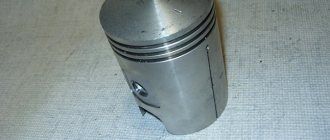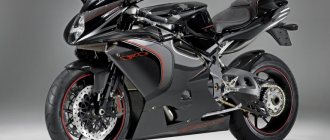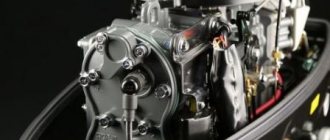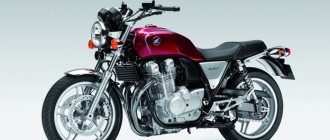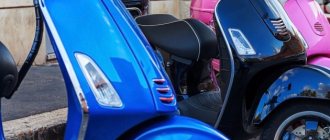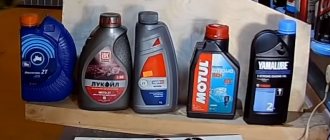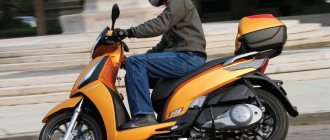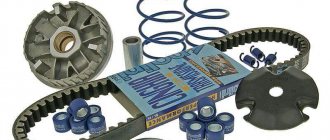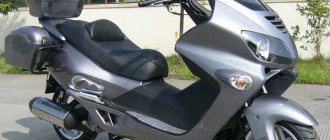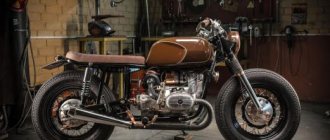- 4-01-2021, 13:40
- Articles / Miscellaneous about cars
- Author: Andymyon
Today, in the description of automobile engines, you can find not only power and torque values, but also prefixes: in-line, V-shaped and opposed, characterizing the arrangement of the cylinders. Despite the fact that each of these schemes is an evolutionary step in engine building, none of them have yet been abandoned. And all because they all have their pros and cons, which you also need to pay attention to when choosing a vehicle.
Engine history
The first patented internal combustion engine was the one developed in 1883 by Gottlieb Daimler and Wilhelm Maybach.
It was a single-cylinder engine developing only 1.1 liters. With. Of course, we did not have to be content with the power of such motors. After all, cars were supposed to replace horse-drawn carriages, taking over all their tasks: transporting people, goods, and so on. Therefore, to increase the power of engines, they began to increase the working volume of the cylinder.
But, as it turned out, there is a limit to everything. Along with the cylinder, it was necessary to enlarge the piston and connecting rod; the loads on these parts increased, and they also had to be taken into account during the design. In addition, the ignition of large volumes of air-fuel mixture in such an engine occurs with a certain pause, which is why it operates unevenly. In this case, it is necessary to install a heavy balancer, and then the structure becomes even heavier and additional energy is needed to set it in motion. As a result, single-cylinder engines became too massive, and the weight increased disproportionately to the power. This led to the fact that it became impossible to make the engine operate at high speeds, and, as is known, the lower the crankshaft rotation speed, the less its power.
A special problem with the 276DT engine for Land Rover
Another, but much rarer, problem with the 276DT engine (2.7-liter engine for Land Rover) is freezing of the crankcase ventilation system breather. In this case, the pressure in the crankcase increases, which most often leads to the squeezing out of the crankshaft front oil seal and very rapid oil leakage, leading to oil starvation.
Also, a violation of the crankcase ventilation system on the 276DT engine is highly likely to cause another problem: the oil used to lubricate the turbine bearings stops flowing into the sump. It either goes into the “hot” part of the turbine, where it burns to form soot. Or the oil begins to go into the “cold” part of the turbine and seep into the intake system. There is an intercooler in its path, where the oil will accumulate. At one point, when a high engine speed occurs, the oil accumulated in the intercooler will literally flow into the combustion chambers. But it will not burn there, but will lead to water hammer.
RESULT
To summarize what has been said, it can be noted that the PSA DT17 / Ford AJD-V6 / 276DT and PSA DT20 / Ford AJD-V6 / 306DT engines have many serious problems that lead to their death. There is an opinion that rotation of the connecting rod bearings occurs due to a manufacturing defect. Let us immediately note that the 3.6-liter V8 does not suffer from these ailments: nothing threatens its crankshaft and liners.
In the event of a breakdown, it is more profitable to replace 2.7- and 3.0-liter turbodiesels with contract ones. Owners of Citroen and Peugeot cars with stuck 2.7 HDI and 3.0 HDI engines often contact Evromotor.by. Recently they replaced a 2.7-liter engine on a Citroen C6 with a mileage of about 230,000 km.
The 2.7-liter DT17 turbodiesel rattled under the hood of the Citroen C6 at a mileage of 230,000 km.
The company Evromotor.by selected and sold a contract motor to the client. The knocking motor was removed and the contract one was installed at the Evromotor.by company's own service station.
Before installing the contract DT17 motor, you must check the condition of the connecting rod bearings.
The main activity of the Evromotor.by company is the sale of contract engines imported from Europe. The Evromotor.by company can select and send any required engine to the address specified by the client in Belarus and the CIS. At the same time, Evromotor.by necessarily and responsibly complies with the terms of the warranty for the engine it sells.
If necessary, the client can order the removal of the faulty motor and installation of the contract motor at the service station of the Evromotor.by company. The replacement time for most engines is 2 days. Large engines, which have to be removed not through the engine compartment, but by lifting the body, are replaced in 3-4 days. Before installation at the Evromotor.by service station, the contract motor is completely inspected: the valve covers and pan are removed, and the condition of the cylinder-piston group is assessed with an endoscope. All in order to provide a 60-day guarantee on the installed contract engine.
APPROXIMATE COST OF ENGINE REMOVAL AND INSTALLATION:
| Motor type and age | Motor replacement cost* |
| 4 cylinders, until 2000 | 400 rubles |
| V6, before 2000 | 600 rubles |
| 4 cylinders, after 2000 | 600 rubles |
| V6, after 2000 | 600 – 800 rubles |
| V10, after 2000 | from 700 rubles |
| The cost of replacing the engine includes work on replacing the timing belt, rollers and other parts at the request of the client. It is also possible to transfer parts from the old motor to the one being installed. Also, if necessary, glow plugs are replaced on diesel engines. |
Evgeniy Dudarevaautospot.by
In-line engine
Row diagram.
This scheme is used with a small number of cylinders (from two to six). The main advantage is that motors of this type are the easiest to balance. The disadvantage is its impressive length. It was soon decided that the crankshaft could move more than just one piston, and several more were added to one cylinder.
The cylinders were placed in a row (this is the easiest way). 2-cylinder engines appeared first, and in 1890 the first 4-cylinder engine appeared. The power of this engine has already reached 5 liters. With. at 620 rpm, but both by today's standards and by the standards of that time this was not enough to move heavy equipment. Therefore, new engines were created, the number of cylinders reaching six, eight and even twelve. And here the manufacturers are faced with the next problem. Such engines required a large amount of free space under the hood. In addition, these engines, due to their weight, made the car heavier, thereby worsening its stability and controllability. Engineers' thoughts turned to creating a more compact engine... By the way, today in-line engines can be found with a maximum of six cylinders. Basically, 4-cylinder engines are built today according to this scheme, since they are the simplest to manufacture.
V-engine
V-shaped pattern.
This arrangement allows you to significantly reduce the length of the motor, but at the same time increases its width. The most common are V6 and V8. In fact, the idea of a compact engine was patented even before the multi-cylinder monsters appeared. This engine was created in 1889. It had two cylinders with a camber angle of 17 degrees and developed 1.6 liters. With. at 900 rpm. The V-twin layout was essentially two engines located next to each other and driving one common crankshaft. This arrangement made it possible to reduce the length of the motor by almost half.
In the automotive industry, the first V-shaped engine appeared in 1905. It was an aircraft engine built by French inventor Leon Levavasseur. At first, engines built according to this design were installed on trucks and buses, and over time they began to be found under the hoods of passenger cars. And yet, despite the many positive qualities of such a scheme, it has not replaced the in-line one. After all, where there are advantages, there are always disadvantages. Mainly this is a more complex design (two gas distribution mechanisms instead of one), and, consequently, the complexity of production and further repairs. In addition, although the overall dimensions have decreased in length, the motors have “grown” in width.
Choosing an electrical system - AC or DC?
Which motor to choose when ordering an electric vehicle - AC or DC?
In the familiar world of internal combustion engines, there are a variety of types: in-line, V-shaped, opposed, rotary, etc. And the only “best” type of engine has not yet been chosen. Different types of motors exist to meet different needs, such as price or performance. This also applies to electric motors. When choosing a golf cart, electric bus or electric truck, one of the most important technical parameters is the type and power of the motor. And if everything is clear with the power - it should be sufficient to solve the tasks assigned to the golf cart, then with the type of motor it is less obvious. There are 2 types on the market - DC motors (brush-commutator direct current motors) and AC motors (synchronous alternating current motors). Sometimes you can find brushless BLDC motors or asynchronous AC motors, but these are rather exotic in the case of low-speed electric vehicles, so we will not add them to the comparison.
DC motors
Many electric vehicle manufacturers, including American ones, still offer equipment with brushed DC motors, usually in the most inexpensive configurations.
Let's try to understand whether it's worth saving on this. Strengths of the motors: • Brush DC motors with series excitation of windings have high torque at start and low speeds. • DC motors are relatively compact and light weight • DC motors are easy to control and require a cheaper controller
But here are the weaknesses of brushed DC motors: • The DC motor has a brush-commutator assembly, which is subject to increased wear of the graphite brushes and commutator. Literally - the brushes wear out on the commutator, over time they require replacement and tend to break. • DC motors, for long service life, must be equipped with a soft motor start device in order to protect the rotor windings from combustion during inrush current • The windings on DC stators generate a lot of heat, which requires complex technologies for dissipation, including stator fins, oil cooling, etc. .d. • The torque of the DC motor decreases with increasing speed
Boxer engine
The boxer engine is a V-twin engine with a camber angle of 180 degrees.
The main advantage is the smallest height and, as a result, a decrease in the center of gravity of the car. Disadvantage: uneven wear. Mostly 4- and 6-cylinder engines are found. One type of V-twin engine that receives special attention is the boxer engine. Essentially, this engine is V-shaped with a cylinder angle of 180 degrees. Basically, such motors are widely used on motorcycles. The transverse (to the direction of movement) placement of the engine improved the cooling of the cylinders by the incoming air flow. However, it also found a place in the automotive industry. From 1938 to 2003, boxer engines were installed on the Volkswagen Beetle, all for the same reason of better cooling (the engine had an air cooling system).
In the 60s, manufacturers busily began developing front-wheel drive cars. Cars with this design, compared to rear axle drive, had advantages on slippery surfaces, and were also simpler and cheaper to manufacture. But as it turned out, not everything is so simple. Due to the heaviness of the engines, front-wheel drive cars of that time could not boast of good handling and balance in corners. Designers began to lower the center of gravity of the engines; they mainly achieved this by “laying the engines on their sides.” And while some automobile companies were experimenting with the location of the engine, Japanese engineers from Subaru in 1966 introduced their first front-wheel drive car, the Subaru-1000, which was equipped with a boxer engine located along the axis of the car. Due to the horizontal arrangement of the engine cylinders, the vehicle's center of gravity has been significantly lowered, thereby improving the stability and controllability of the vehicle.
However, such motors have not found widespread use. This is due to a number of disadvantages: uneven wear of the cylinders (due to the point distribution of loads, the cross-section of the cylinder becomes elliptical over time), high oil consumption and poor crankcase ventilation. Boxer engines today can be found in Subaru and Porsche cars, for which handling comes first.
Implementation of new innovative projects
Entering the 21st century, manufacturers are no longer interested in straight sixes. Jeep killed its AMC 4.0L I6 after 2006 in favor of V6s. General Motors, unique for its time, created the I6 in 2002 as part of its new Atlas engine family, which lasted until 2012. Only BMW continued to base most of its lineup on the straight six.
Short hoods remain a challenge for accommodating an inline engine, but Mercedes has a few tricks up its sleeve to shorten the M256 enough to squeeze it into today's snub-nosed cars.
On a classic engine, the power to drive the power steering, alternator, compressor and air conditioning is transmitted through a system of rubber belts on pulleys that are located at the front of the engine. All this takes up a lot of valuable engine compartment space between the engine block and the front grille. The M256 inline-six engine gets rid of belts and pulleys.
It is equipped with systematic electrification devices. Thus, there is no belt drive at the front of the engine for auxiliary components, which reduces its overall length. The narrow design, together with the physical intake/exhaust separation, creates space for exhaust aftertreatment close to the engine. At 500cc, the new engine has the same displacement per cylinder as the family of premium diesel engines used previously, as well as the family of four-cylinder petrol engines. An additional bonus is the original modification of the in-line engine.
The power and torque of the new six-cylinder in-line engine are similar to the current eight-cylinder car, i.e. more than 300 kW (408 hp) and more than 500 Nm. Compared to the previous V6, CO 2 emissions from the engine have been reduced by approximately 15 percent.
Its performance is as dynamic as that of the V8, as the new in-line six-cylinder engine is equipped with an intelligent turbocharging design: with ISG support when starting the electric auxiliary compressor (eZV), a rapid build-up of high torque is guaranteed when driving and accelerating when it is necessary to overcome the regime, after which turns on the large turbocharger.
The electric supercharger accelerates to 70,000 rpm within 300 milliseconds, providing extremely high engine response. The result is dynamic engine response without turbo lag—the delay that occurs with turbocharged engines due to the “turbo lag” you feel between pressing the gas pedal and receiving a boost of power.
The six-cylinder inline engine has some advantages in both production and performance over the V6.
The M 256 is the first member of a new family of premium petrol engines that have been systematically developed from the outset using electrification elements. The 48V electrical system not only services high-power consumers such as the water pump and air conditioning compressor, but also has an integrated starter generator (ISG) that also supplies energy to the battery through highly efficient energy recovery. ISG eliminates the need for a belt drive for these components. This not only reduces the overall length of the engine and its complexity, but also opens up new efficient control options. The still existing 12V system supplies power to consumers such as lighting, cockpit, infotainment and control devices.
The ISG is a key component of the 48V system and not only serves as the alternator, but is also responsible for the hybrid functions. This saves fuel, which was previously reserved for high-voltage hybrid technology. For the first time, the ISG is also responsible for idle speed control. Hybrid features include 15kW more power and 220N more torque, energy recovery as well as shifting the load point - the engine can operate in a more favorable performance area with a corresponding increase/decrease in load depending on the battery charge level.
Another feature of the new family of premium petrol engines is exhaust gas pre-treatment. The standard particulate filter is the only part of the exhaust system that is located under the floor.
VR - in-line-biased engine
VR-shaped scheme.
Motors with a small camber angle (about 15 degrees). This angle made it possible to install both banks of cylinders in one cylinder block, which made it possible to reduce not only the length, but also the width of the engine. The main disadvantage is the additional shafts and unusual timing design, which is why it is very expensive to produce. Another type of cylinder arrangement includes an in-line-displaced engine, designated by the index VR. This engine is a combination of V-twin and in-line engines. The pistons move at an angle of 15 degrees, which allows them to be located in the same cylinder block. When creating this engine, the designers tried to make maximum use of the advantages of the V-shaped and in-line engine: small overall dimensions (both in length and width), ease of manufacture. But creating the perfect motor was not an easy task. These motors have high thermal stress. Thin walls between the rows of cylinders do not allow for a sufficient number of channels for coolant, as a result of which these engines are less resistant to overloads.
W engine
W-shape.
There are two layout options - three rows of cylinders with a large camber angle (e) and a combination of two VR-shaped schemes (e). Currently, W8 and W12 are produced. The pursuit of power led to the birth of engines built according to the W scheme. These are, in fact, two VR engines, the angle between which is 72 degrees, or three in-line ones. The main disadvantage of such engines is that there are twice as many connecting rods on the crankshaft as on the V-shaped one, and four times! more than in a row. The connecting rods are made thin, and since these parts are among the most loaded in the engine, as a result they begin to bend at high speeds. Such motors are not created for mass use. They can only be found on sports cars.
